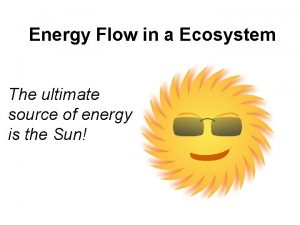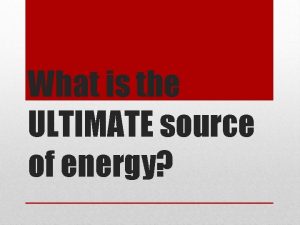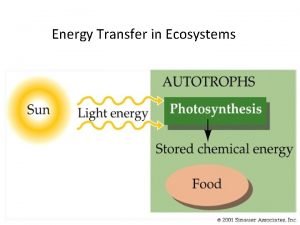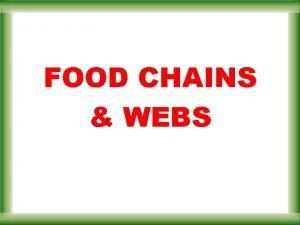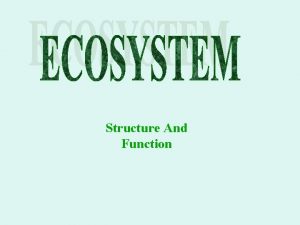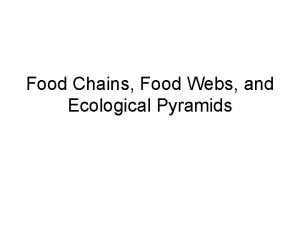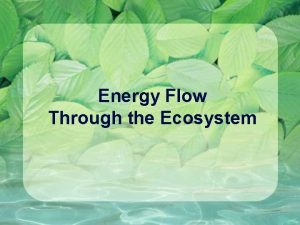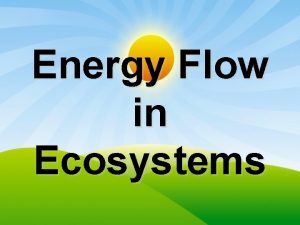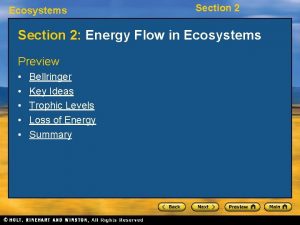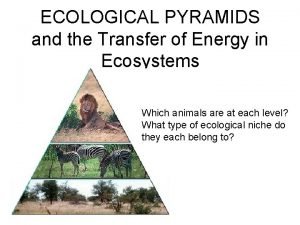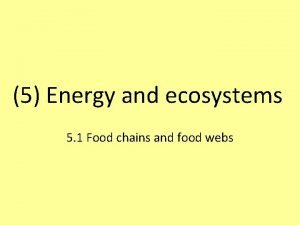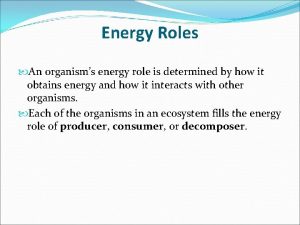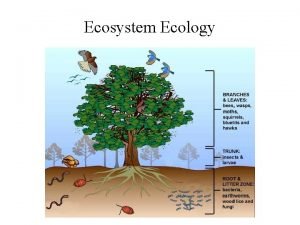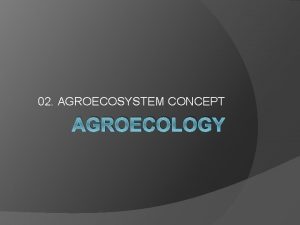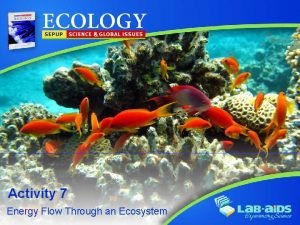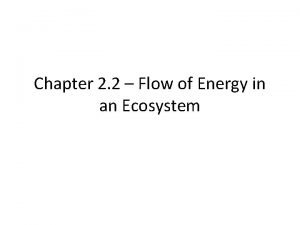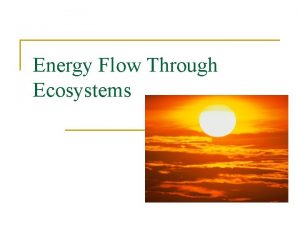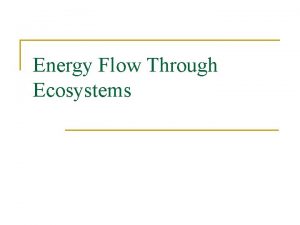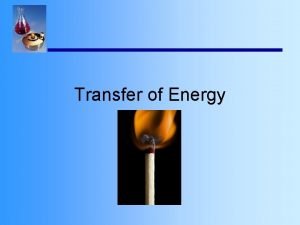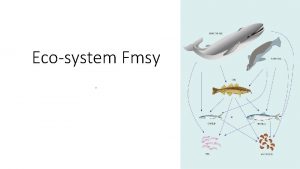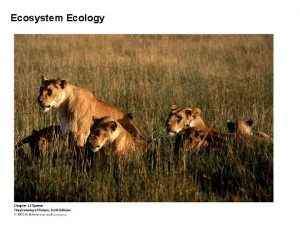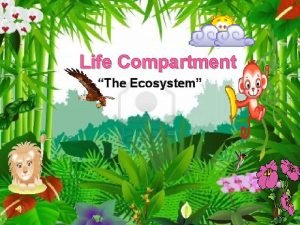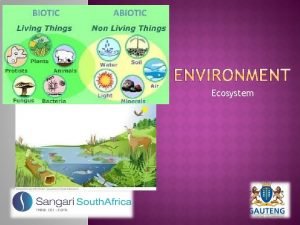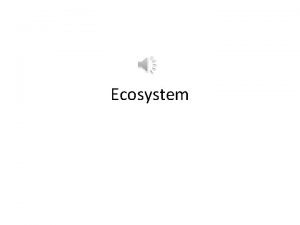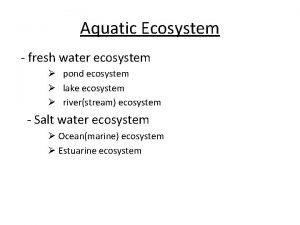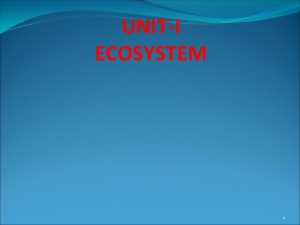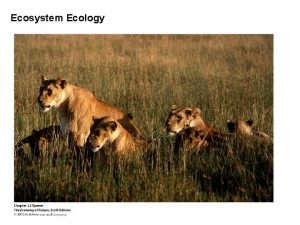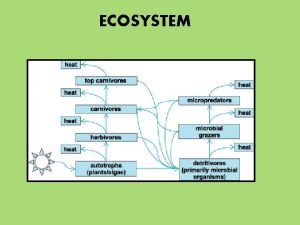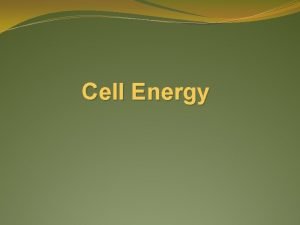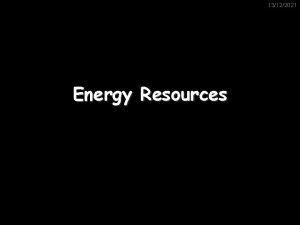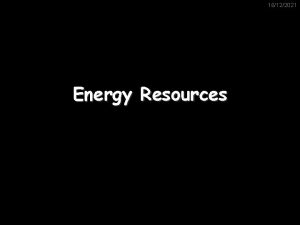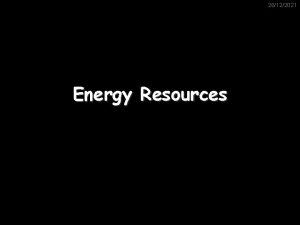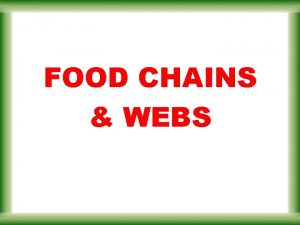Energy Transfer in an Ecosystem The ultimate source













































- Slides: 45

Energy Transfer in an Ecosystem

• The ultimate source of all energy on earth is the sun • Role of Organisms in Energy Transfer: 1) Producers: capture energy from the sun and use it to make simple energy-rich molecules (ex: glucose). Another name for a producer is an autotroph Ex: plants, blue-green bacteria

• Role of Organisms in Energy Transfer: 2) Consumers = cannot make their own food, must obtain nutrients by eating other organisms. Another name for a consumer is a heterotroph Ex: Animal, amoeba Three Types: carnivores (meat only), omnivores (meat and plants), and herbivores (plants only)

• There are different “trophic levels” that represent the different levels of energy transfer. • organism that eats a producer: primary consumer • organism that eats a primary consumer: secondary consumer

Algae Zooplankton Mackerel Squid Shark • How many trophic levels are in the food chain shown above? ____ • Identify the trophic level of each organism Organism Algae Zooplankton Mackerel Squid Shark Trophic Level

Algae Zooplankton Mackerel Squid Shark • One trophic level was left out of our food chain… the decomposers or detritivores • Description: organisms that break down dead organic matter as a food source; help recycle nutrients throughout the ecosystem

Food Chains vs. Food Webs • Which is a better method for showing the energy -transfer relationships in an ecosystem and why? Check out the pics and come up with your own answer!


Food Web Practice A) Which organism is a producer? B) Which organisms are primary consumers? C) Which organism is both a secondary and tertiary consumer? D) What does the snake eat? E) Which organism would be most affected by the extinction of the cricket?

Efficiency of Energy Transfer • The total mass of organic matter (living stuff) at each trophic level is called the biomass • Only 10% of the energy/biomass from one level can be transferred to the next level. • Why is this? – not all energy-containing material can be eaten or digested Ex: bird beaks, cellulose in plants, teeth

Biomass vs. Energy Pyramids Below is a basic biomass pyramid

Biomass vs. Energy Pyramids • Below is a basic energy pyramid

Limiting Factors • Limiting Factors = an abiotic factor or biotic factor that restricts the numbers, reproduction, or distribution of organisms. – Abiotic Limiting Factor: Sunlight, climate, temperature, water, nutrients, fire, soil chemistry, and space – Biotic Limiting Factor: living things

Range of Tolerance • Environmental factors: – Each organism has an upper and lower limit for survival • Steelhead trout • Ideal water temp range = 13 degrees c – 21 degrees c • Can survive at lower temps – Physiological stress = inability to grow & Reproduce

Range of Tolerance • Tolerance = the ability of any organism to survive when subjected to abiotic or biotic factors. – Steelhead trout • Optimal Zones • Zone of Physiological Stress • Water temp = a limiting factor

Ecological Succession • Ecological Succession = the change in an ecosystem that happens when one community replaces another as a result of changing abiotic and biotic factors. – Example: Forest Fire • May negatively impact some organisms and positively impact others

Primary Succession • Primary Succession = The establishment of a community in an area of exposed rock that does not have any topsoil. – Usually occurs very slowly at first

Pioneer Species • Pioneer Species= First organisms to appear, help create soil by secreting acids that help to break down rocks. – Lichens – Mosses

Primary Succession • Pioneer organisms die • Decaying organic material & bits of sediment from rocks = first stage of soil development • Small weedy plants (ferns) & other organisms like fungi and insects become established – Organisms die and more soil is created

Primary Succession • Climax Community = the stable, mature community that results when there is little change in the composition of species. – Very unlikely to occur!!!

Secondary Succession • Secondary Succession = the orderly and predictable change that takes place after a community of organisms has been removed but the soil has remained intact. – Pioneer species are the first species to start secondary succession

Secondary Succession • Community of organisms changes over a period of time • Secondary succession usually occurs faster than primary succession: – Soil already exists – Some species will be present already

Succession’s End Point • Natural communities change at different rates – Succession is very slow • Human activities affect the species that are present – Hard to determine if a species has reached a climax community

Population Dynamics

• Population = a group of organisms of the same species that live in a particular area • Population Density= the number per unit area • Population Growth = (increasing the density of a population) usually cannot continue forever. When a population can no longer grow it has reached its carrying capacity.

• Things that affect population growth can be either biotic (living) or abiotic (nonliving), and can depend on how big the population already is • Limiting Factors = components of the environment that limit the growth of a population

Spatial Distribution • Dispersion = The pattern of spacing a population within an area that depends upon the availability of resources (food).

Population Range • Population Range = the total area in which a species can live. – Range size depends upon the availability of a suitable habitat. – Ex. Mountain lions require a habitat with: • Diverse Plant Life • Large Hunting Territory • Prey animals

Population-Limiting Factors • Population limiting factors keep a population from continuing to increase indefinitely • Density-Independent Factors = usually abiotic; include natural phenomena such as weather events & human-caused phenomena. • Density-Dependent Factors = usually biotic; any factor in the environment that depends on the number of members in a population per unit area.

• Types of Limiting Factors 2) Density Independent = limits the size of a population no matter what the density is Examples: natural disasters (tornadoes, hurricanes, forest fires etc. )

Density-Independent Factors – Human Caused • Human alterations of landscape can also limit populations – Colorado River • Reduced water flow + increase in water temp + introduction of nonnative fish species • # of Humpback chub is reduced • Air, Land & Water Pollution

• Types of Limiting Factors 1) Density Dependent = limits the size of a population when the population reaches a certain density (number of organism per area) Examples: food or water shortage, disease, predation

Types of Population Growth 1) Exponential Growth = population increases quickly in size (can only happen for short periods of time when there are no limiting factors) We call the graph pictured to the right a Jcurve Example in Nature: rapid bacteria growth in a new host (body)

Types of Population Growth 2) Logistic Growth = population grows quickly for some time and then stops growing once it reaches its carrying capacity, the total number of individuals the environment can support We call the graph pictured to the right an S-curve Example in Nature: grizzly bear population (limited by territory size)


Carrying Capacity • Carrying Capacity = the maximum number of individuals in a species that an environment can support for the long term. – Limited by: • • Energy Water Oxygen Available Nutrients

Human Population Growth • Useful Measurements = birth rate, death rate (AKA mortality rate), life expectancy, age structure

Age Structure Pyramids • What is different about these two pyramids? • Which country/population seems to be growing more? • List several reasons why a developed country like France might have a different age structure than a developing country like India.

• The growth rate is determined by: birth, death, immigration, and emigration • Immigration = the movement of organisms into a population • Emigration = the movement of organisms out of a population

Emigration/Immigration • Emigration = the number of individuals moving a way from a population • Immigration = the number of individuals moving into a population

Reproductive Patterns • R-Strategist = produce as many offspring as possible in a short time period in order to take advantage of a particular environmental factor

R-Strategists – – – Don’t raise offspring Controlled by density-independent factors Don’t maintain a population near the carrying capacity Short Life Small Organisms (fruit fly, mice, locust)

Reproductive Patterns • K-Strategist = produce only a few offspring that have a better chance of living to reproductive age

K-Strategists • • • Raise offspring Controlled by density-dependent factors Maintain a population close to the carrying capacity Long Life Large Organisms (elephants, humans)

KEYSTONE SPECIES - species that influences the survival of many other species Bats are considered keystone species of many ecosystems.
 Ultimate source of energy in an ecosystem
Ultimate source of energy in an ecosystem The ultimate source of the energy in food is ________.
The ultimate source of the energy in food is ________. Primary consumers
Primary consumers Energy energy transfer and general energy analysis
Energy energy transfer and general energy analysis Energy energy transfer and general energy analysis
Energy energy transfer and general energy analysis Ecosystem energy transfer
Ecosystem energy transfer Calvinists beliefs
Calvinists beliefs Ultimate energy food web
Ultimate energy food web Transfer transfer
Transfer transfer Structure and function of ecosystem
Structure and function of ecosystem In a food web what do the arrows represent
In a food web what do the arrows represent How does energy flow in a food web
How does energy flow in a food web Abiotic
Abiotic Chapter 2 section 2 flow of energy in an ecosystem
Chapter 2 section 2 flow of energy in an ecosystem Tansely
Tansely Total amount of living tissue within a trophic level
Total amount of living tissue within a trophic level Pyramid of energy in ecosystem
Pyramid of energy in ecosystem How does energy enter an ecosystem? *
How does energy enter an ecosystem? * Energy roles
Energy roles Energy flow and material cycling in ecosystem
Energy flow and material cycling in ecosystem Agroecosystem concept
Agroecosystem concept Energy flow in ecosystem
Energy flow in ecosystem Describe the flow of energy in the kelp forest ecosystem.
Describe the flow of energy in the kelp forest ecosystem. Principles of ecology 2 flow of energy in an ecosystem
Principles of ecology 2 flow of energy in an ecosystem How does energy flow in an ecosystem
How does energy flow in an ecosystem Energy flow
Energy flow Energy roles in an ecosystem
Energy roles in an ecosystem How does energy flow through an ecosystem
How does energy flow through an ecosystem Hát kết hợp bộ gõ cơ thể
Hát kết hợp bộ gõ cơ thể Lp html
Lp html Bổ thể
Bổ thể Tỉ lệ cơ thể trẻ em
Tỉ lệ cơ thể trẻ em Gấu đi như thế nào
Gấu đi như thế nào Tư thế worms-breton
Tư thế worms-breton Hát lên người ơi
Hát lên người ơi Các môn thể thao bắt đầu bằng tiếng nhảy
Các môn thể thao bắt đầu bằng tiếng nhảy Thế nào là hệ số cao nhất
Thế nào là hệ số cao nhất Các châu lục và đại dương trên thế giới
Các châu lục và đại dương trên thế giới Công của trọng lực
Công của trọng lực Trời xanh đây là của chúng ta thể thơ
Trời xanh đây là của chúng ta thể thơ Cách giải mật thư tọa độ
Cách giải mật thư tọa độ Phép trừ bù
Phép trừ bù độ dài liên kết
độ dài liên kết Các châu lục và đại dương trên thế giới
Các châu lục và đại dương trên thế giới Thơ thất ngôn tứ tuyệt đường luật
Thơ thất ngôn tứ tuyệt đường luật Quá trình desamine hóa có thể tạo ra
Quá trình desamine hóa có thể tạo ra
